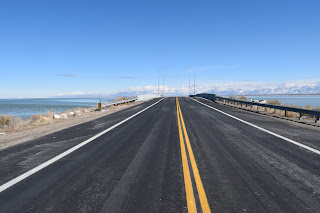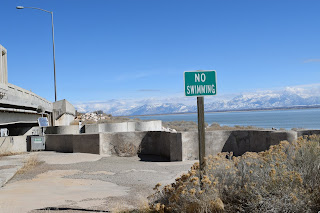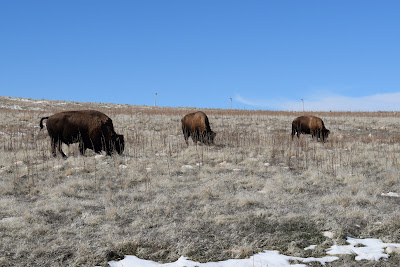We were in Rapid City, SD for 5 days. That's a long time to stay someplace without a conference to attend, or a relative to visit with. The last day we stayed there I was finally recovered from the cold I'd been carrying around with me and, with Kristi, visited the local shopping mall. It was just across the street from where we were staying so it wasn't a long journey to get there. Kristi had already been there. There's an old saying that I think I acquired from my maternal grandfather, Ben Hart. "I didn't just ride into town on a load of hay." or "I think he just rolled into town on a load of hay." Please excuse me farmers. We visited a store called "Happy Days". I looked around a bit and very soon had to think that one had to be some kind of sucker to actually buy something there.


This is only one example. They had full life mannequins of the "Rat Pack", and I only wish I could remember all of the things we saw there. There WAS some entertainment value, short lived though it may have been. The place was full of novelties.
On the other hand we stayed in that shop for about 20 minutes thinking how dumb someone had to be to buy this stuff, at the same time thinking about how an Elvis gas pump would look in the living room. It was a nice respite off of the hay truck.
We played at The Firehouse Wine Cellars on Friday night. We played straight through two hours of music and had the opportunity to play a lot of songs off of our new CD, "Windows". I had to have a souvenir so I bought a beer mug. They have The Firehouse Brewery just a couple of doors down from the wine cellars.
In Rawlings, WY I bought a 4 pack of Boddington bitter to go with the mug. The mug is quite satisfactory for drinking beer. I guess you could put water in it too.
We hung around the winery for awhile after we played. They gave us a taste of the wines that they make and I gotta say I was sorely tempted to spring for a bottle of the stuff, but was already well stocked for alcoholic beverages and there's only so much room for stuff in the car etc.
The night before we were watchng the news and they were doing a special story on the South Dakota drought. Now there's something I hadn't thought about, heard about, knew nada about. There were a couple of farmers being interviewed and they were talking about how without more water they wouldn't have enough grass to feed their cattle. It was a sad story of expectations dashed, and dreams cancelled. One of them was explaining how he couldn't afford another winter paying for out-of-state grass to feed his cattle, and that under the circumstances he was going to have to cut the size of his herd. It really seemed like a classic example of bad things happening to good people.
Of course as I write this I realize that there are other perspectives. I've been reading, listening to friends, etc about the inefficiency of using meat as a food source for humans. Cattle add methane to the atmosphere, and you could grow another crop where the cattle are, and at the very least you could feed a lot of the food that goes to cattle to humans. There's the shallow version. On the other hand if you grew up on a farm growing cattle for the beef market, and it's all you know it is still a sad day when you are forced out of business by mother nature.
The next day we were on our way to Rawlings, WY and we decided to take a side trip to Devil's Tower. We have been blowing through the prairies like a tumbleweed in a hurricane, seeing nothing that you can't see out of a windshield of a vehicle traveling between 65 and 85 mph.
It was about a 50 mile round trip. Well, kinda round trip as we started in Sundance, WY and ended in Moorcroft, WY. It was a more exciting experience than I expected it to be. Perhaps part of it is just the idea that we were going to see something just to go see it. I had heard about it for years so it was a thrill to see it poking out of the Wyoming landscape from a distance.
I stopped at a few of the viewing opportunities on our way and took pictures as it got bigger, and bigger, and bigger.

There weren't very many people living out that way, although I've seen a lot less populated parts of Wyoming by this time. Kristi and I started to think of the little place along Kluane Lake where we used to stop from time to time on our way to Whitehorse, or Dawson City. Finally we arrived at the door to the park. I don't know what I was expecting. I guess I was expecting I'd be able to just drive up a road and be at the foot of the thing so when the guard asked us if we had a senior pass it was a wakeup. I had totally forgotten that I had bought the thing, and I don't even remember where I purchased it. It was one of those deals that you get it now or you don't get it at all so I got it not knowing for sure if I'd ever need it. It was $20 for under 62 and $10 if you were over 62. So I'm looking through my wallet, and I don't really see the thing when the gate guard, who was a woman not much younger than me, said, "There it is!". She was watching the contents of my wallet as I pulled them out. What a surprise! That was just when I was thinking I had lost the thing, or had hallucinated the very existence of it.
Once we got inside the park it wasn't too long a drive to the Visitor's Center and we immediately began behaving like proper tourists We took each other's picture with the tower in back of us.
We went in the Visitor's Center and bought postcards. We talked to the guy behind the counter who was from Moorcroft and after a life in retail sales thought that this was a pretty good career. It pleases me to hear that folks are enjoying their lives and the people that they work for are treating them well, so it was a pleasant conversation. Also when we drove out through Moorcroft I could say I knew someone from there.
These are the last two pictures I took of Devil's Tower. By the time we got to Rawlings I had all but forgotten about our late morning excursion.

After Devil's Tower we got back on I-90, but pretty soon we were turning off onto a smaller road. Very soon I saw two eagles on the side of the road dining on coyote carcass. It was one of those things where you see "something" on the side of the road. You're unsure just what it is you are viewing because it is not really light enough and maybe there was too much light behind them. Besides you are driving on a two lane, ice covered road with the snow blowing across it so you're not really paying attention to what's going on elsewhere. Nonetheless I was able to exclaim to Kristi that she should look and saw the four to six foot wingspan of an eagle taking off as we whizzed by. We both were kind of in shock and discussed for awhile just what it was we had been seeing. Then a little farther down the road there was another eagle casually dining on a carcass on the side of the road. By then I was in a "get where we need to go" mode of travel, but thought about going back for a picture.
The rest of the day was driving, driving, driving stopping only for gasoline and restrooms. We drove past acres and acres of oil fields and fracking stations. We speculated on how much the farmers were making off of growing crops or beef, and how much they were making off of oil and gas. We saw an antelope herd making friends with a herd of cattle. I wondered if they realized that they were communicating with "food". I posted this on Facebook and a Facebook friend pointed out that many people see the antelope as "food" as well. "Give me a home, where the buffalo roam and the deer and the antelope play. Where seldom is heard a discouraging word, and the skies are not cloudy all day."
This got stuck in my head and played over and over and over as we drove through the wild prairies of Wyoming.
It blew all day. When we got to Rawlings it was still blowing. The snow was drifting and the motel parking lots were all filled with snow.
Kristi was driving by the time we arrived and we got stuck in the motel parking lot of the first place we tried to check into. Whoever was supposed to be at the desk was apparently taking a nap and we were tired, cold and impatient. Even the place where we eventually stayed had snow drifts that we had to break through to get into the parking lot, and then the snow was drifted up to the door of our room so we were tracking in snow. Pretty normal stuff huh? OK.
The next day was more relaxed. You could be tiring of hearing about snow, blowing winds, and tracts of rocks, and grassy plains full of snow by now. It could seem boring to you. Believe me, you don't want to get bored when driving through this stuff. You want to be at your coffee best, watching carefully, keeping your hands on the wheel and the wheels on the road. Honestly. We had heard that it was warmer in the vicinity of the Great Salt Lake so after Rawlings, WY that was what we set our course for. I'm not sure I've seen as many trucks on the highway anywhere as we saw between Rock Springs, Wyoming, and Layton, UT. There were really a lot, and we've seen a lot of trucks so that means a LOT of trucks. Once again there were times when you couldn't see the surface of the road for the snow blowing over it. It even started snowing once.
Like I say it was a relatively relaxed day. We decided to stop in Rock Springs, Wyoming to see if it was really the shithole that we remember it as. I was optimistic that we were somehow mistaken about our impression of the town. There was a sign pointing to the "historic" downtown area.
Let me just say that Jesse Kimmerling would probably recognize this town. It is a petroleum products kind of a place surrounded by mining operations, fracking stations, oil wells etc. There are also processing plants. The original housing that Kristi and I remember seeing in the hills surrounding Rock Springs in the summer of 1982 was mostly doublewide trailers. Now there are prefabricated homes, and I think probably some pretty nice houses. There is gold in them thar hills. I'm pretty sure of that. I think that is the point. Rock Springs is aptly named. If there hadn't been snow on the hills all we would have seen would have been mud and rocks. Hardly anything grows around there. The historic downtown looks very haphazard. Here. I'll put some illustrations in.
 |
Lingeries, Bachellorette Party Supplies, Novelties, Piercing and Tattooing,
Exotic Shoes and Boots |
This is the "nice" part of town. It is the "historic" part of town. I would play there, but I don't think I want to live there. My intuition is that if anybody really wanted to live there the town would look a lot nicer than it does. It's really a big place actually, and this is just a tiny part of it. The population was over 23,000 in 2016.
 |
| Welcome to Utah |
It was really nice to drive into the vicinity of Salt Lake City. We are staying in Layton, just a few miles out of the city. It is very urban here. There are spectacular views of mountains all around us here, and the Great Salt Lake is just a few miles away. We moved into a motel room and immediately set out to see the Great Salt Lake. We went to Antelope Island State Park. It is a really nice park immediately adjacent to Layton. It was after 4 in the afternoon by the time we got there. The park closes at 6, and the visitor's center closes at 5. It was Sunday afternoon.




We've had some time to get around town a little bit now. SLC, Layton, and environs are pretty much another stop along the way. The same businesses service anything you want to do, and the TV says the same thing it says in other places. I don't hear much radio around here, but that's OK. I think I'll have a look at Democracy Now at democracynow.org when I log off of here. I won't say anything about the possibilities of national theocracy, or when religion holds excessive power in a region (and there a lot of them in this country that have these characteristics).
At any rate, this is a beautiful locale where there are no people present. Nothing against people, but I'm more a fan of the natural world than I am of humanity. Please don't take that personally. I love people too. This communication stuff can get downright difficult at times.
Don't let the wind blow you into the snow off the road. We'll see you soon. Steve N.






















































